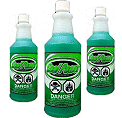RC Glow Fuel ('Nitro')
RC glow fuel, also often called nitro fuel, is a special blend of three main ingredients, plus a few minor additives, used in radio control model engines.
There are several different blends of glow fuel available, suited to different types of engine and performance requirements.

The three main ingredients are methanol, oil (Castor or synthetic) and nitromethane, the latter being the one that puts the word nitro into so many rc terms (nitro plane, nitro car, nitro engine...) even though rc glow fuels don't always contain it!
It's not necessary to don your chemistry lab coat and round glasses to understand rc glow fuel completely, but a basic understanding of how and why it makes your rc engine run isn't a bad thing. Hopefully this article will try and explain those basics of the fuel...
Glow Fuel Ingredients
Contrary to popular belief, nitromethane isn't the primary and sole explosive ingredient of rc glow fuel - methanol is.
Whilst nitromethane is very flammable, it's generally added to aid smoother running of the engine.
When more nitro is used (i.e.a higher percentage) it contributes more to the power output of the engine. Nitro releases oxygen when it burns, and so more fuel can be introduced into the combustion chamber to make use of this extra oxygen.
More fuel equals a bigger explosion, which equals more power.
The primary ingredient for the burn within the combustion chamber is the methanol, a type of alcohol that's very flammable.
Methanol on its own doesn't need much air to burn, so it burns well with the limited amount of air inside the combustion chamber. An equivalent amount of petrol or diesel wouldn't burn as much as methanol with such limited air supply.
A vital property of methanol is that the vapour produces a catalytic reaction to the glow plug filament which is made of platinum.
This reaction, combined with the heat inside the combustion chamber, is what keeps a glow plug glowing red hot all the time.
So in the methanol vs. nitromethane world, methanol is essential for glow fuel whereas nitromethane is optional, although highly desirable for better engine running and more power.
Oil Ingredient
The final, and very essential, ingredient of rc glow fuel is oil, either castor or synthetic, obviously necessary for the lubrication of the engine, to protect rubbing metal parts from wearing.
Castor oil is the traditional oil used in model aero engines. It's a natural oil produced from the castor bean and has excellent lubricating qualities.
The downside to castor oil is that it leaves a gummy residue after it has burned, which with time can build up inside your model engine.
If left unmaintained, this residue can build up and harden to a varnish-like surface, causing all manner of problems for your engine. And, because of the way it burns, castor oil will leave a bigger mess from your model's exhaust.
Synthetic oil is one that has been produced from artificial, laboratory-produced chemicals.
Synthetic oil, because of its artificial additives, burns cleaner than castor oil and won't leave a gummy residue inside the engine. The downside is that synthetic oil can be broken down by the other ingredients of the glow fuel, particularly at high temperatures. If this occurs, obviously your engine isn't going to get the lubrication it needs.
A castor/synthetic oil mix is an option, and this gives the best of both worlds; the cleanliness of synthetic and the better lubrication of castor.
RC Glow Fuel Blends
When choosing a suitable rc glow fuel for your model engine, you should follow the engine manufacturer's recommendations primarily.
Once you've broken your engine in you can of course experiment with different fuels, by trying various blends.
The word blend refers to the concentration of each ingredient, and different blends are used for different performance requirements.
The main percentage you'll see is the nitromethane content. This varies and for rc airplanes it can range from a low 5% to a whopping 40%. For general sport flying a 10% to 20% range is considered acceptable with 15% being commonly used, although this is a big generalisation.
The other common percentage shown on rc glow fuels is the oil content. For general flying, again, anywhere between 15% and 20% is considered to be a standard amount.
Apart from the kind of performance you need from your engine, the other thing that will determine your fuel blend choice is whether your engine is 2-stroke or 4-stroke.
RC Glow Fuel Care
It's very important to store your glow fuel well. Always read the manufacturer's instructions on storing the fuel properly.
Whilst rc fuel does have a long shelf-life, it can go off.
One of the biggest dangers is moisture contamination. Methanol can easily absorb moisture molecules from the atmosphere, and if they do get into the fuel then it's pretty much wrecked.
A tell-tale sign will be small droplets of condensation on the inside of the fuel bottle above the level of fuel, or on the underside of the lid. If this happens, dispose of your fuel safely and replace it with new.
Always read what the manufacturer says about storing your fuel, but keeping it in its proper container with the lid screwed tightly on, at room temperature and well away from any sources of ignition is the safest way.
 Because of how rc glow fuel burns, it does leave an oily residue in the exhaust smoke. This can easily build up on the surface of your airplane throughout a days flying.
Because of how rc glow fuel burns, it does leave an oily residue in the exhaust smoke. This can easily build up on the surface of your airplane throughout a days flying.
For this reason, it's always a good idea to take a bottle of fuel cleaner to the field with you, and get in to the habit of cleaning your model before going home.
